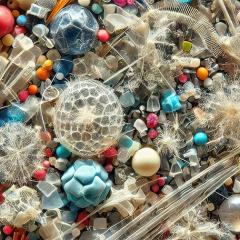Microplastics (MPs) are small-sized plastic particles that can be purposefully manufactured at that size for special applications or produced as a result of oxidation, UV exposure, and mechanical forces fragmenting larger plastic waste in the open environment. In both cases, microplastics are defined as having a size ranging from 5 mm to 1 µm. MPs have been extensively identified and quantified in most of the environmental samples that have been studied so far in different locations worldwide which include marine fauna such as bivalves and lobsters, fish, marine mammals and reptiles, as well as terrestrial animals such as earthworms and birds. Additionally, microplastics have been reported in sediments, sand, and water in seas, rivers and estuaries, wastewater treatment plants, soil and both indoor and outdoor air. Nanoplastics (NPs) are even smaller particles generated from larger plastics and are defined as being smaller than 1µm. As of now, human exposure to micro and nanoplastics (MNPs) as well as their potential health effects and fate within human bodies is an area of active ongoing research. There are studies that reported MPs in human lung, colon, liver, placenta tissues also in urine, faeces, blood, and breast milk. On the other hand, studies related to infant exposure are fewer and have included analysis in meconium, faeces, baby formula, and feeding and storage containers. Thus, it is important to determine the possible sources of exposure to MNPs for infants as this might have an important health impact for them. The present research project aims to evaluate the infant oral exposure to micro and nanoplastics originated from infant formula, breast milk and breast milk storage containers.
Please note this is a PhD student progress review presentation.

